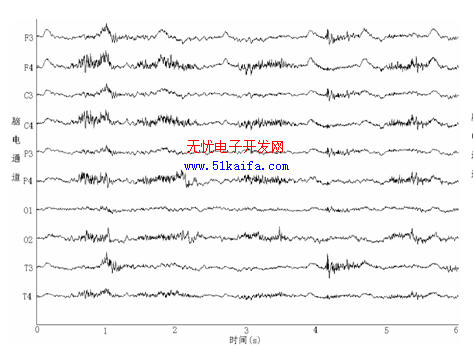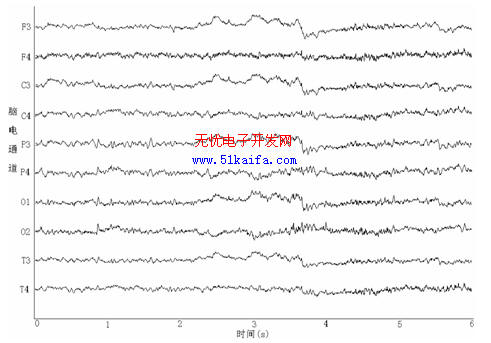Introduction [1]
Wavelet transform and independent component analysis are two kinds of signal processing methods that have been studied in recent years, and they have applications in EEG signal preprocessing and feature extraction. However, in the process of measuring EEG signals, the different interference signals, which signal processing method is better, and their respective application conditions, need to be analyzed and studied in actual experiments. In this paper, we conducted two methods to analyze and remove the two types of common EEG interference signals during driving in the experiment of studying the EEG characteristics of car drivers. The advantages and disadvantages of the two methods in removing EEG interference were analyzed. Respective application conditions.
1 Wavelet transform and independent component analysis
Wavelet transform [1,2] (Wavelet Transform) is a typical time-frequency analysis method. Its basic idea is to use a set of wavelet functions to represent or approximate the signal. This set of wavelet functions is the translation and expansion of a wavelet basis function Obtained, the analysis window area is fixed, but its shape can be changed, that is, both the time window and the frequency window can be changed. In the low-frequency part of the signal, the wavelet transform has a higher frequency resolution and a lower time resolution. In the high-frequency part, the wavelet transform has higher time resolution and lower frequency resolution. In recent years, wavelet transform has been widely used in the analysis of non-stationary signals such as EEG.
Independent component analysis [3,4,5] (Independent Component Analysis for short ICA) is a new blind source separation method developed in recent years (BlindSource SeparaTIon for short BSS). This method has great application potential in many fields of signal processing, and its theoretical development can be traced back to the early 1980s. However, it was not until the mid-1990s that the research on ICA theory and algorithms was truly developed and received widespread attention from the international signal processing community. It has also achieved considerable progress in biomedical signal processing, mixed speech signal separation, and image denoising. Good application effect. The object processed by ICA is a set of mixed signals generated by linear combination of mutually independent sources. The ultimate goal is to extract individual signal components from the mixed signal.
During the recording of EEG signals, signals caused by non-brain electrical activities are often mixed in. These signals are called artifacts. There are many types of artifacts in EEG, the more common ones are ECG, EMG, blink, eye movement, sweating, and power frequency interference. Because EEG signals are generated by the activity of neurons in the cerebral cortex, and eye activity, muscle activity, power frequency interference, ECG signals, etc. are usually not restricted by brain activity, so the ICA separable conditions are met. For EEG signals, The conduction from the inside of the cortex to the scalp electrode is considered to be approximately linear, so it can also be considered that the EEG is a linear combination of signals from independent sources to the recording electrode. At this time, the ICA method can be used to separate the interference components from other bioelectric signals from the multi-channel EEG signals and the interference from other external environments to achieve the purpose of noise reduction.
2 EEG interference while driving a car
The EEG measurement in the driving environment of the car is different from the EEG measurement in the hospital and laboratory environment. Traditional EEG measurements are generally performed in a special electromagnetic shielding environment. At the same time, the environment is quiet and requires the testee to maintain Stand still. However, the measurement of EEG during actual car driving cannot meet such requirements. The actual EEG interference during driving mainly includes electromagnetic interference of the surrounding environment, such as cell phone interference, and the driver's own interference, such as eye electrical interference.
In this paper, the disturbed EEG signals obtained from the actual driving EEG experiment are used as the analysis objects to illustrate the processing effect and application scope of the two signal processing methods. Figure 1 (a) and (b) show the EEG signals interfered by mobile phone and eye electrical interference, respectively.

(A) EEG signal interfered by mobile phone (b) EEG signal interfered by eye electrical interference
Figure 1 Interference with EEG signals
The figure shows a total of 10 EEG channels, each channel is 6 seconds of data, the sampling frequency is 500 Hz, and a total of 3000 data points. The abscissa is the EEG sampling time (s), and the ordinate is the EEG amplitude (μv) of each EEG channel.
The following two methods of wavelet transform and independent component analysis are used to analyze and remove the above two interference signals respectively.
3 Wavelet transform to remove interference
The wavelet transform first involves the selection of wavelets. The most commonly used in EEG signal processing is db (Daubechies) wavelet, usually the wavelet base in the Daubechies system is denoted as dbN, N is the sequence number, N = 1, 2, ⋯, 10. In the dbN series of wavelets, the smaller the N, that is, the smaller the support length, the smaller the scale that can be detected, so we need to select the appropriate scale for the actual frequency range of the EEG signal to detect. By comparison, this article uses db5 wavelet to the brain Analysis of electrical signals.
Then there is the determination of the number of wavelet decomposition layers. The acquisition frequency of EEG signals is 500 Hz. According to the sampling theorem, the range of EEG signals is 0 to 250 Hz. Therefore, by performing 6-layer decomposition of the EEG, 7 decomposed signals can be obtained, in order of frequency from high to low: cd1: 125-250Hz; cd2: 64-125Hz; cd3: 32-64Hz; cd4: 16 to 32 Hz; cd5: 8 to 16 Hz; cd6: 4 to 8 Hz; ca6: 0 to 4 Hz.
Finally, the decomposed wavelet components are analyzed to remove interference. Because the acquisition frequency set by the EEG instrument in the subject experiment is 0.53 to 60 Hz, the cd1 and cd2 components are false components and can be removed directly. The interference of mobile phone signals to EEG is mainly high-frequency interference, which is concentrated on the cd3 component, but the data in this frequency band may also have EEG information that needs to be used, so an appropriate threshold should be selected for processing. Comparing the mean value of the cd3 component of the wavelet decomposition of EEG without interference, the threshold hcd3 is determined. If it is greater than hcd3, it is considered to be high-frequency interference. The commonly used threshold functions are hard threshold and soft threshold [6]. , Directly set to zero, therefore, the EEG signal after removing the mobile phone interference is y = cd4 + cd5 + cd6 + ca6 + cd3, where cd3 is zero when the absolute value exceeds hcd3. The interference frequency of EEG is generally about 4Hz, which is generally in the ca6 component, but if the blink speed is relatively fast, it may be greater than 4Hz, so it may also be in the cd6 component. The threshold value of the component is set. Similarly, the thresholds are determined as hca6 and hcd6 according to the average value of the ca6 and cd6 components of the EEG wavelet decomposition without interference. The hard threshold method is also adopted, and the EEG signal after removing the electrooculogram interference is y = cd3 + cd4 + cd5 + cd6 + ca6, wherein when ca6 and cd6 exceed the thresholds hca6 and hcd6 respectively, it is zero.
There are a total of 10 channels of EEG signals in the experimental signal. The wavelet transform method is the same for each channel. For convenience, this article only gives the wavelet removal results of the F4 channel signal. Figure 2 (a) (b) gives the results of wavelet transform on the removal of mobile phone interference and eye electrical interference EEG signals.

(A) Mobile phone interference removal results

(B) Removal result of electroocular interference
Figure 2 Wavelet transform removal results
4 Independent component analysis to remove interference
The independent component analysis method needs to use multiple channels of EEG signals, and then divide the signals of each channel into their own independent signals. According to the characteristics of the interference, the independent components of the interference signal are found and removed, and the remaining independent components are recombined to obtain Remove the interference signal. Figure 3 (a) (b) gives the results of the independent component analysis method to remove electromagnetic interference and eye electrical interference EEG signals.
(A) Electromagnetic interference removal result (b) Eye electrical interference removal result
Figure 3 Independent component analysis removal results
5 Comparison and analysis of the removal results of the two methods
Comparing the removal effect of mobile phone interference: comparing Figure 2 (a) and Figure 3 (a), the wavelet transform method is better than the independent component analysis method. The reason is that mobile phone interference belongs to high-frequency interference. The wavelet transform method can extract the high-frequency part of EEG more clearly and then remove it. However, among the individual components decomposed by the independent component analysis method, it is impossible to clearly determine which component is caused by mobile phone interference, so the effect is not ideal.
Compare the removal effect of EOG interference: From Figure 2 (b), it can be seen that wavelet transform removes some of the original low-frequency waves of EEG during the removal of EOG interference. Obviously these are not EOG interference; It can be seen from 3 (b) that the independent component analysis method removes the electroocular interference of each channel better, and does not affect other EEG. The reason is that the frequency of EEG interference is not very fixed, and it coincides with the useful frequency band of EEG, so it is inevitable that it will be erroneously removed when it is removed, and the EEG interference is resolved independently by the independent component analysis method. The component is a very clear component, so the electroocular interference can be removed very accurately.
The following conclusions can be obtained through analysis:
(1) Both wavelet analysis and independent component analysis can be applied to remove EEG signal interference.
(2) The wavelet transform is better than the independent component analysis method for the removal of electromagnetic interference from mobile phones, and the independent component analysis is better than the wavelet transform for the removal of electro-ocular interference.
(3) The advantage of wavelet analysis is that the algorithm is mature and the calculation amount is small, but each EEG channel data needs to be processed separately. It is suitable for the situation where fewer EEG channels are required and the real-time requirement is high.
(4) The advantage of independent component analysis is that the spatial information of EEG is used, which can remove the interference of multiple channels at the same time, but the calculation amount is large. Therefore, it is suitable for situations where there are many required EEG channels.
6 Conclusion
In this paper, the characteristics and application conditions of the two methods in the removal of EEG interference while driving are analyzed and compared by using wavelet transform and independent component analysis method to analyze the mobile phone interference and EOG interference signals of EEG while driving. It laid the foundation for the extraction and further application of the driver's EEG information.
The author's innovation:
By comparing the effects of wavelet analysis and independent component analysis on the removal of EEG signals during car driving, the advantages and disadvantages of the two methods in the preprocessing of EEG signals and their respective applicable ranges are clarified.
Star Lights Bunnings,Star Eagle Lights,Star Lights Lamp,Led Stargazer Lights
XINGYONG XMAS OPTICAL (DONGGUAN ) CO., LTD , https://www.xingyongxmas.com